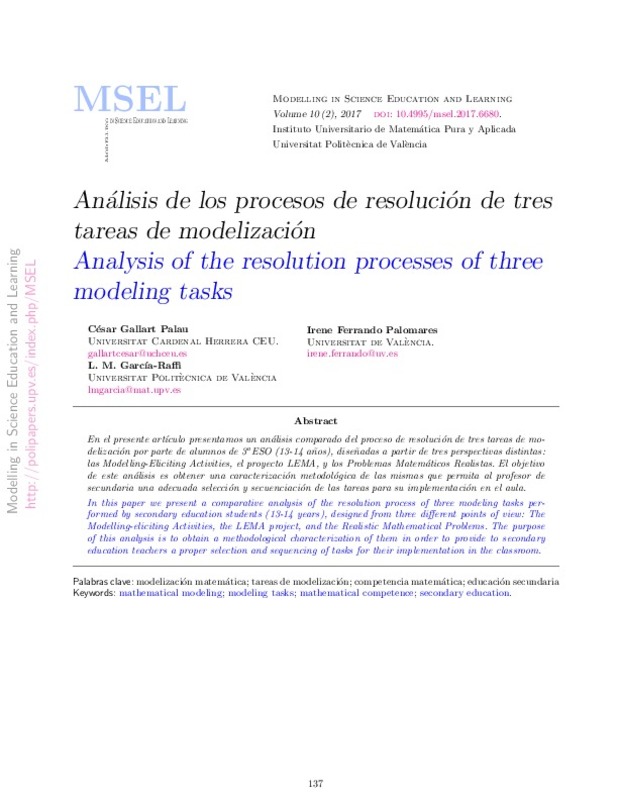Ärlebäck, J. B., & Doerr, H. M. (2015). Moving Beyond a Single Modelling Activity. Mathematical Modelling in Education Research and Practice, 293-303. doi:10.1007/978-3-319-18272-8_24
Borromeo-Ferri, R. (2006). Theorical and empirical differentiations of phases in the modeling process. Zentralblatt für Didaktik der Mathematik, 41, 453-465.
Galbraith, P., & Stillman, G. (2006). A framework for identifying student blockages during transitions in the modelling process. ZDM, 38(2), 143-162. doi:10.1007/bf02655886
[+]
Ärlebäck, J. B., & Doerr, H. M. (2015). Moving Beyond a Single Modelling Activity. Mathematical Modelling in Education Research and Practice, 293-303. doi:10.1007/978-3-319-18272-8_24
Borromeo-Ferri, R. (2006). Theorical and empirical differentiations of phases in the modeling process. Zentralblatt für Didaktik der Mathematik, 41, 453-465.
Galbraith, P., & Stillman, G. (2006). A framework for identifying student blockages during transitions in the modelling process. ZDM, 38(2), 143-162. doi:10.1007/bf02655886
Gallart C., Ferrando I. y García-Raffi L.M. (2015). El profesor ante la actividad modelizadora en el aula de secundaria. SUMA, 79, 9-16.
Lesh R. y Doerr H. M. (2003). Foundations of a models and modeling perspective on mathematics teaching, learning, and problem-solving. En R. Lesh y H.M. Doerr (Eds.), Beyond Constructivism: Models and modeling perspectives on mathematics problem solving, learning, and teaching. (pp. 3-34). Mahwah, New Jersey: Lawrence Erlbaum & Associates.
Lesh R., Hoover M., Hole B., Kelly A. y Post T. (2000). Principles for Developing Thought-Revealing Activities for Students and Teachers. En A. Kelly y R. Lesh (Eds.), Handbook of Research Design in Mathematics and Science Education. (pp. 591-645). Mahwah, New Jersey: Lawrence Erlbaum & Associates.
Maaß, K. (2006). What are modelling competencies? ZDM, 38(2), 113-142. doi:10.1007/bf02655885
Maaß, K. (2010). Classification Scheme for Modelling Tasks. Journal für Mathematik-Didaktik, 31(2), 285-311. doi:10.1007/s13138-010-0010-2
Maaß, K., & Gurlitt, J. (2011). LEMA – Professional Development of Teachers in Relation to Mathematical Modelling. Trends in Teaching and Learning of Mathematical Modelling, 629-639. doi:10.1007/978-94-007-0910-2_60
Niss M. (2003). Quantitative Literacy and Mathematical Competencies. En B.I. Madison y L.A. Steen (Eds.), Quantitative Literacy | Why Numeracy Matters for Schools and Colleges. (pp. 215-220). Princeton, NJ: National Council on Education and the Disciplines.
Niss M. (2004). Mathematical competencies and the learning of mathematics: the Danish Kom project. En Gagtsis y Papastavridis (Eds.), 3rd Mediterranean Conference on mathematical education, 3-5 January 2003, Athens, Greece. (pp. 115-124). Athens: The Hellenic mathematical society.
Pollak, H. O. (1969). How can we teach applications of mathematics? Educational Studies in Mathematics, 2(2-3), 393-404. doi:10.1007/bf00303471
Vilatzara, Grup (2001b). Experiencias sobre proyectos e investigaciones matemáticas en secundaria. Revista Números. Revista de Didáctica de las Matemáticas. Sociedad Canaria Isaac Newton de Profesores de Matemáticas, 46, 29-46.
[-]









